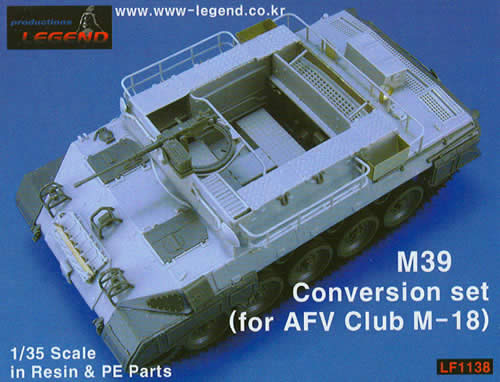|

Legend
Productions
LF1138
First
LookThe
M39 was one of the first American-designed fully tracked armored personnel carriers—then
called "armored utility vehicles"—which appeared nearly too late
for WWII but served well in Korea. Based on the lightly armord but highly mobile
M18 tank destroyer chassis, it gave good service in the rough Korean terrain and
provided good support to recon units. Legend
now offers a complete drop-in conversion kit for the M39 designed to fit specifically
on the AFV Club M18 chassis. Unlike some conversions, such as Sherman hulls, due
to the differences between this kit and the Academy M18 they are not kidding,
and these parts both will not fit on the Academy kit nor can they be adapted to
fit it. Surprisingly
this kit comes with rather heavy pour plugs for the major components, which will
be tedious to remove and clean up. Add to that the fact that for some reason my
review copy was made from a particularly odious type of resin and this will be
a very unpleasant chore for most modelers (read: do it outside or in a VERY well
ventilated area.) The
rear deck grille comes as a solid resin casting, which is a bit disappointing
as there are kits out for the exhaust assembly and engine for this kit and somebody
should have planned on an opening with an etched brass grille; since the kit comes
with a small sheet of etched brass, this makes it even more difficult to figure
why they didn't do that. All
of the basket assemblies, formed from mandrel-bent steel tube on the original
vehicle, come as resin castings on this model which again will be tedious to clean
up. My suggestion is use them as a pattern and replace them with 0.030" (0.75mm)
plastic rod or brass wire as that will be easier to work with than the resin bits
in the kit. The
interior comes in five major sections: floor, sidewalls, firewall and a stowage
bin or rack behind the driver's seat. Once cleaned up, these interlock and fit
firmly into the AFV Club hull, and also interlock with the upper hull for a nice
tight fit. Most
of the rest of the details come straight from the AFV Club kit, and are a drop-fit
into the resin hull which comes with pre-spotted holes and projections to attach
them as per the base kit. No
markings or finishing instructions are provided, and the model is only shown in
its unpainted form in the directions and box art. The directions are of little
help, basically only showing the parts in the kit and then the assembled model,
with no clues or hints as to how to get one to turn into the other. ConclusionIn
summary, this kit is a bit disappointing, given the high quality of other manufacturers'
products and state-of-the-art resin casting elsewhere. But the basic components
are accurate and sharply molded, fit well when cleaned up, and other than the
rear engine deck grilles most of the odd bits can be either easily replaced or
compensated for during construction. Media
and Contents: 75 parts (63 parts in creme colored resin, 11 etched brass, 1 length
of brass wire)
Price: Price estimated at US $45-60
Advantages: Drop-in
fit for this early US armored personnel carrier, neatly designed fit for the AFV
Club kit.
Disadvantages: Method for construction of the various baskets and
racks very tedious and fussy; heavy pour plugs to clean up or remove.
Recommendation:
Recommended for all American APC and Korean War fans.
Thanks
to Peter Brown via Ian Hanratty from Friendship
Models for the review sample. -Cookie
Sewell-
| 











